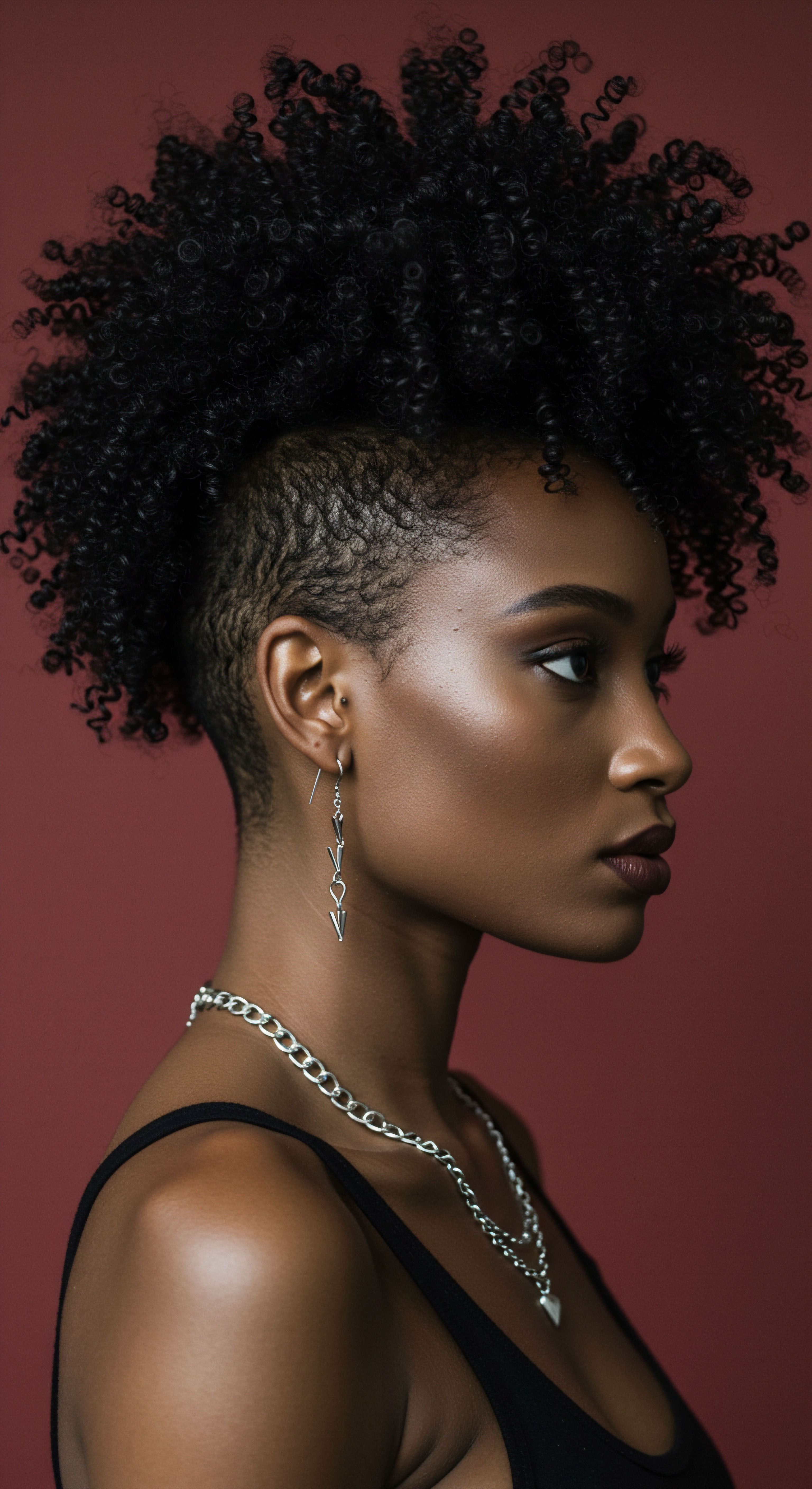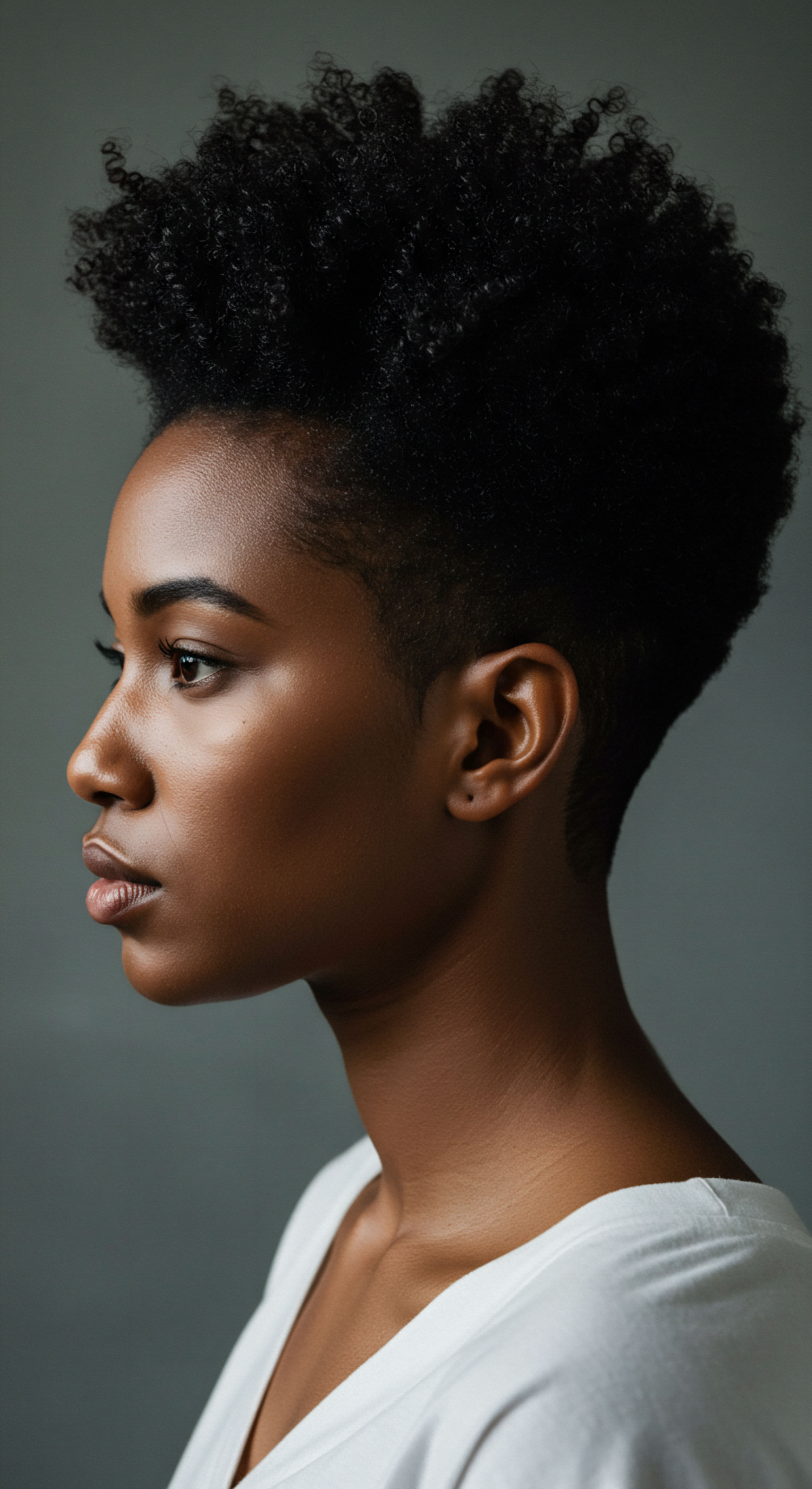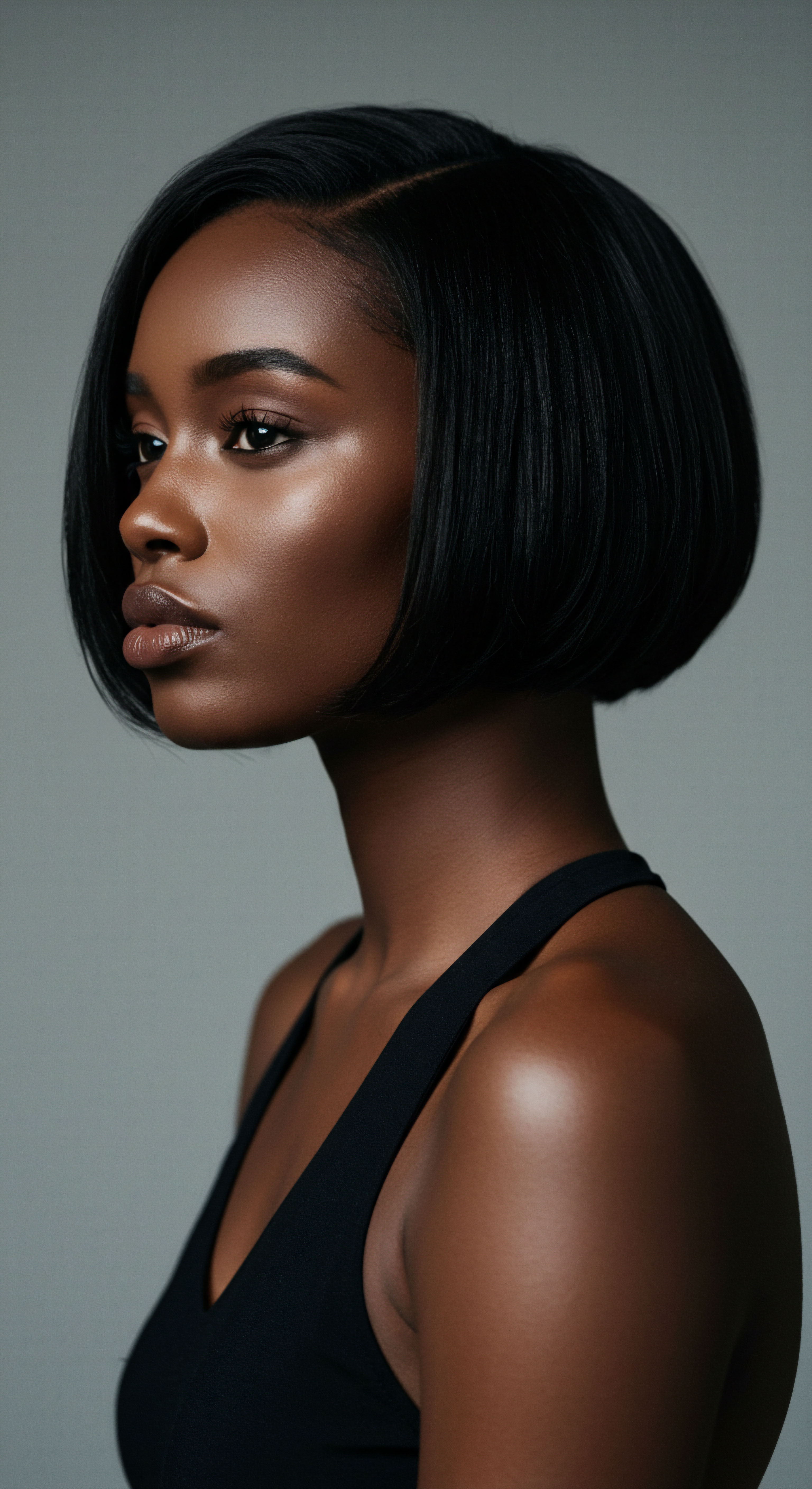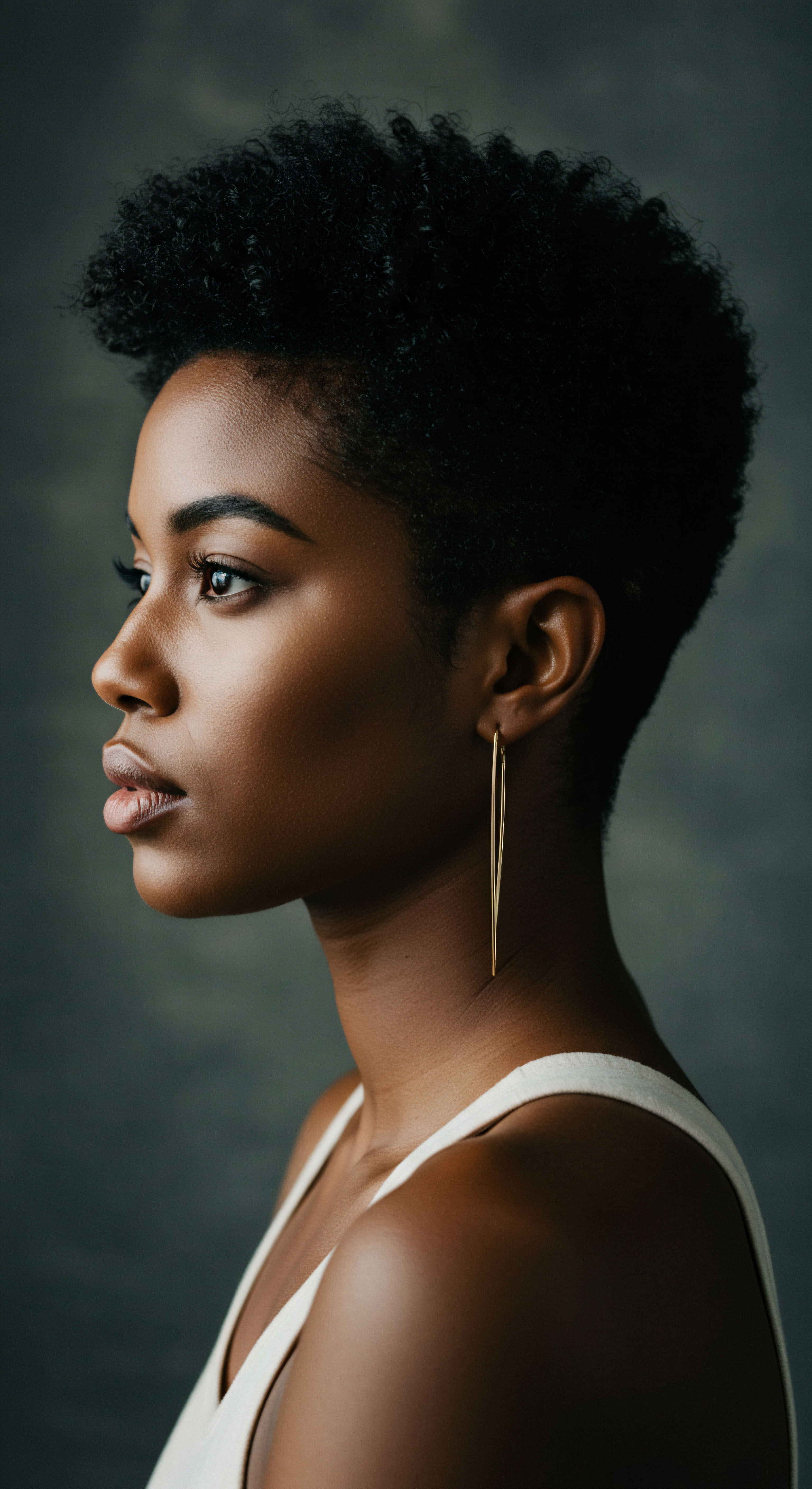
Roots
The whisper of ancient sands often carries echoes of forgotten rituals, yet few resonate with the quiet intimacy of personal adornment. Consider for a moment the human desire to sculpt one’s appearance, to craft a visual narrative for the world to see. In the sun-drenched landscape of ancient Egypt, this impulse found a remarkable expression in the artistry of wigs.
Far from mere accessories, these elaborate constructions were deeply woven into the fabric of daily existence, demanding a level of attentive upkeep that speaks volumes about their significance. To truly appreciate the archaeological traces of their daily care, one must first understand the fundamental role these hairpieces played in Egyptian society, how they were conceived, and from what they were fashioned.
Wigs served a multitude of purposes, extending beyond simple aesthetics. They offered protection from the harsh desert sun, shielding delicate scalps from its relentless glare. For a populace concerned with cleanliness, wigs provided a practical solution to the challenges of maintaining natural hair hygiene in a hot climate, often serving as a barrier against lice and other pests.
Beyond utility, they were potent symbols of status, wealth, and even spiritual connection. The more elaborate the wig, the higher the individual’s standing often appeared to be.
The creation of these ancient masterpieces was a painstaking process, relying on readily available materials. Human hair, often sourced from slaves or collected, formed the primary component, meticulously braided and layered onto a foundation of plant fibers, such as palm leaf or linen netting. Sometimes, sheep wool or even vegetable fibers were incorporated, particularly for less affluent individuals or for specific stylistic effects. The craftsmanship involved in their assembly suggests a dedication to durability and form, hinting at an expectation of prolonged use and, consequently, regular attention.

What Constituted an Ancient Egyptian Wig?
Ancient Egyptian wigs were not simply extensions of natural hair; they were distinct, carefully constructed entities. Their foundations were typically made from woven plant fibers, creating a sturdy yet pliable base. Upon this, strands of human hair, or sometimes wool or vegetable fibers, were attached in a variety of methods.
These methods ranged from knotting individual strands to adhering larger sections with resins or beeswax. The density and length varied enormously, from short, tight curls favored by laborers to cascading, voluminous styles seen on royalty and high officials.
- Materials Human hair was the preferred medium, often meticulously prepared and dyed.
- Foundations Woven linen or palm fiber nets provided the structural support for the hair.
- Adhesives Natural resins, beeswax, and sometimes animal fats were used to secure hair strands to the base.
The materials chosen for wig construction also influenced their maintenance. Organic components, like human hair and plant fibers, are susceptible to degradation, dust accumulation, and insect activity, underscoring the ongoing need for preservation and cleansing. The very composition of these artifacts, as revealed through archaeological analysis, provides the initial clues into the care they must have received.
Ancient Egyptian wigs were more than fashion; they were multifaceted expressions of status, hygiene, and protection, built from diverse organic materials demanding diligent care.

Ritual
Stepping from the foundational understanding of ancient Egyptian wigs, we arrive at the intimate sphere of daily practice. Just as we tend to our own hair with a mindful rhythm, the Egyptians, too, engaged in a sequence of care for their prized hairpieces. This was not a haphazard affair but a purposeful ritual, a testament to the value placed on these items.
The archaeological record, though often fragmented, offers compelling glimpses into the tangible acts of cleansing, conditioning, and styling that maintained the integrity and beauty of these revered adornments. It invites us to consider the hands that meticulously smoothed, the tools that carefully untangled, and the substances that brought a lustrous sheen to these symbolic crowns.
Evidence for wig care emerges from a diverse array of artifacts discovered in tombs and domestic settings. Combs, often crafted from wood, bone, or ivory, are among the most common finds. These combs, with their fine and coarse teeth, mirror designs still in use today, suggesting their enduring function in detangling and styling both natural hair and wig fibers. Brushes, sometimes made with bristles set into wooden handles, also appear in the archaeological record, indicating their use in removing dust and debris from the wig’s surface.

What Tools and Substances Aided Wig Maintenance?
The toolkit for wig care extended beyond simple combs and brushes. Depictions in tomb paintings and papyri often show servants attending to their masters’ or mistresses’ wigs, sometimes holding small containers or implements. These visual records complement the physical evidence.
Substances found in cosmetic jars and residues on artifacts offer further insight. Ancient Egyptians were masters of botanical and animal-derived compounds. Fatty acids, beeswax, and various plant oils (such as moringa, castor, and olive) have been identified through chemical analysis of residues found in cosmetic vessels and on mummified hair and wigs.
These compounds would have served as conditioners, emollients, and styling agents, providing shine, pliability, and a pleasant scent. The application of these substances would have helped to preserve the wig fibers, preventing them from becoming brittle or dry in the arid climate.
One particularly telling piece of evidence comes from the meticulous analysis of hair samples from mummies, which often wore wigs or had elaborate hairstyles that required similar care. A study published in the Journal of Archaeological Science detailed the chemical analysis of hair from 18 ancient Egyptian mummies, dating from the New Kingdom to the Roman Period. Researchers identified a complex mixture of fatty acids, including palmitic, stearic, and oleic acids, alongside evidence of beeswax.
This specific lipid mixture was not simply a styling product but also likely functioned as a preservative, helping to maintain the integrity of the hair over millennia. This finding underscores a deeper understanding of ancient Egyptian “beauty” products as sophisticated formulations with both aesthetic and practical, long-term preservation goals.
| Artifact Type Combs |
| Material Wood, Bone, Ivory |
| Proposed Function Detangling, styling, distributing oils |
| Artifact Type Brushes |
| Material Wood, Bristles |
| Proposed Function Dust removal, smoothing, gentle cleansing |
| Artifact Type Cosmetic Jars |
| Material Alabaster, Pottery |
| Proposed Function Containing oils, fats, resins |
| Artifact Type Curling Rods |
| Material Wood, Bronze |
| Proposed Function Creating and maintaining curls |

How Do Depictions Inform Our Understanding of Wig Care?
Beyond the tangible objects, visual representations provide invaluable context. Tomb paintings frequently depict scenes of daily life, including personal grooming. These scenes often show servants or attendants applying oils, combing hair, or holding mirrors for their elite masters.
While not always explicitly showing wig care, the consistent portrayal of hair and body tending rituals strongly implies that wigs, as a prominent aspect of personal presentation, received similar attention. The gestures, the implements, and the substances depicted offer a visual lexicon for understanding the practical steps involved in maintaining these elaborate coiffures.
The very presence of these items within funerary contexts further reinforces their importance. Alongside grave goods meant to sustain the deceased in the afterlife, wig stands, often intricately carved, and containers of cosmetic substances are frequently found. This suggests that the desire for well-maintained hair, even in the realm of the dead, persisted, emphasizing the enduring cultural significance of wigs and their care.
Archaeological finds like combs, brushes, and chemical analyses of residues reveal ancient Egyptians used sophisticated mixtures of fats and oils for wig conditioning and preservation.

Relay
As we delve deeper into the archaeological narrative surrounding ancient Egyptian wigs, a more intricate picture of their care begins to surface, moving beyond mere functionality to reveal a complex interplay of science, social status, and cultural values. The daily attention lavished upon these hairpieces was not simply a matter of aesthetics; it was a profound expression of identity, an economic indicator, and a testament to an advanced understanding of material preservation. How did the societal roles and scientific insights of the era shape the very fabric of wig maintenance, and what subtle messages do the surviving fragments of their care convey across millennia?
The preservation of wigs, whether on mummies or as freestanding artifacts, speaks volumes about the quality of their initial construction and the ongoing care they received. Many wigs exhibit signs of repeated application of fatty substances, visible as dark, sticky residues on the hair strands. These residues, when analyzed, often show a consistent chemical profile of animal fats (like beef tallow) and beeswax.
This suggests a deliberate and systematic approach to conditioning, aimed at keeping the hair pliable, reducing breakage, and possibly deterring insect infestations. The choice of these particular substances also highlights an understanding of their emollient and protective qualities, perhaps gained through generations of empirical observation.

Did Wig Care Reflect Social Standing and Economic Status?
The archaeological evidence strongly suggests that the intensity and quality of wig care were often correlated with social standing. Elite individuals, whose wigs were more elaborate and costly, would have employed servants specifically for grooming tasks. Tomb scenes, as mentioned, depict such attendants, indicating that the labor involved in wig maintenance was a visible marker of wealth and leisure. The very act of having someone else tend to one’s wig underscored a person’s elevated position within society.
Moreover, the materials used in wig construction and care were themselves indicators of economic capacity. Human hair, particularly long, fine strands, would have been a valuable commodity. Exotic oils and resins, though often locally sourced, would still represent a certain expenditure.
The meticulous preservation of these items, as evidenced by the condition of many surviving wigs, points to their significant material and symbolic value. A poorly maintained wig would have been as much a social misstep as a tattered garment, diminishing the wearer’s perceived status.

What Scientific Insights Do Wig Residues Provide?
Modern scientific techniques, such as gas chromatography-mass spectrometry (GC-MS) and scanning electron microscopy (SEM), have provided unprecedented insights into the ancient practices of wig care. Analysis of residues on ancient Egyptian combs, for instance, has revealed traces of lipids, proteins, and even plant materials, corroborating the use of various conditioning agents. The presence of pollen grains or specific plant fibers can sometimes even indicate the season in which a wig was last cleaned or styled, or the geographic origin of its components.
A particularly compelling, albeit less commonly highlighted, finding relates to the persistent challenge of hygiene. While wigs offered some protection against lice, archaeological studies of mummified hair and wigs themselves have revealed the presence of lice eggs (nits) in a significant number of samples, even on individuals of high status. For example, research by Dr. Louise Schofield on mummified remains, including those from the Amarna period, has consistently shown evidence of head lice, indicating that despite elaborate grooming practices and the use of wigs, these parasites remained a pervasive issue.
This challenges the simplistic notion that wigs were a complete solution to hygiene problems; rather, they were part of a complex system of personal care where fashion and status often intersected with, and sometimes superseded, absolute eradication of pests. The continued presence of nits, even on meticulously cared-for wigs, suggests that the daily ‘care’ was a constant battle against environmental factors and parasites, rather than a definitive victory. This nuance provides a more grounded understanding of the practical realities of ancient Egyptian daily life.
Advanced scientific analysis of ancient wig residues reveals not only conditioning practices but also the persistent challenge of parasites, complicating simplistic views of ancient hygiene.
This persistence of parasites, despite apparent care, underscores a deeper point ❉ ancient Egyptian wig maintenance was a continuous, adaptive process, not a one-time application of a perfect solution. The archaeological record does not just present us with static objects; it presents us with the echoes of dynamic, ongoing human effort to maintain appearance, health, and social standing in a challenging environment. The evidence of wear, repair, and repeated treatment on many surviving wigs further supports this idea of continuous care and adaptation.

Reflection
As the dust of millennia settles, the whispers from ancient Egypt about wig care invite us to consider more than just the practicalities of grooming. They speak to an enduring human desire for self-expression, for crafting one’s presence in the world, and for the deep connection between outward appearance and inner sense of self. The diligent hands that once smoothed and scented these elaborate hairpieces remind us that hair, in all its varied textures and forms, has always been a canvas for identity, a testament to cultural values, and a subject of continuous, gentle attention. It is a quiet affirmation that the reverence for hair, for its vitality and its aesthetic power, transcends the boundaries of time and culture, linking our modern routines to the timeless rituals of those who walked before us.

References
- Fletcher, Joann. “Ancient Egyptian Hair ❉ A Study in Egyptology and Human Biology.” Manchester University Press, 2017.
- Schofield, Louise. “The Royal Cemeteries of Amarna.” The British Museum Press, 2007.
- Lucas, Alfred. “Ancient Egyptian Materials and Industries.” Dover Publications, 1999.
- Dawson, Warren R. “Magician and Leech ❉ A Study in the Relations of Medicine and Magic in Ancient Egypt.” Routledge, 2013.
- Manniche, Lise. “An Ancient Egyptian Herbal.” University of Texas Press, 2006.
- David, Rosalie. “Handbook to Life in Ancient Egypt.” Facts on File, 2007.
- Robins, Gay. “The Art of Ancient Egypt.” Harvard University Press, 2008.
- Brewer, Douglas J. and Emily Teeter. “Ancient Egypt ❉ Foundations of a Civilization.” Pearson Prentice Hall, 2000.